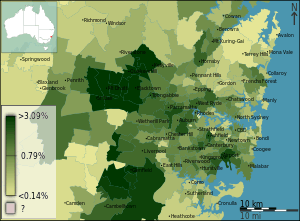Filipino Australians
| Total population | |
|---|---|
|
232,386 (Philippines-born) 304,015 (Filipino ancestry)[1] | |
| Regions with significant populations | |
| Most are found in Sydney, New South Wales and Melbourne, Victoria[2] | |
| Languages | |
| Australian English, Tagalog, Visayan languages (Cebuano and Hiligaynon), Kapampangan, Pangasinan, Ilocano | |
| Religion | |
| Roman Catholicism · Protestantism · Irreligion | |
| Related ethnic groups | |
| Filipino people and Overseas Filipinos |
Filipino Australians (Filipino: Pilipino-Australyano) are Australians of Filipino ancestry. Filipino-Australians are the fifth-largest subgroup of the Overseas Filipinos. According to the 2016 census, there are over 304,015 Filipino Australians.[1] In Sydney, people born in the Philippines comprise 5.9% of the population in the City of Blacktown and it is the largest directly born ethnic group in Blacktown.[3]
Population

Currently Filipinos are the third largest Asian Australian immigrant group behind Indian Australians and Chinese Australians.[1] Females account for 61% while males represent 39% of Filipino Australians born in the Philippines.[1] According to census data, 50.2 per cent of the Philippines-born were resident in New South Wales, followed by 21.6% in Victoria, 14.9% in Queensland and 5.2% in Western Australia.
History
Filipinos were excluded from entering Australia under the White Australia policy. As a consequence, their numbers in Australia remained minimal; confined to descendants of those few Filipinos who had migrated to the north west pearling areas of Western Australia and the sugar cane plantations of Queensland prior to 1901; until the abolition of racially selective immigration policies in 1966.[4] The 1901 census had recorded 700 Filipinos in Australia.[4]
Martial law in the Philippines, declared by former Philippine president Ferdinand Marcos in 1972, and the renunciation of the White Australia policy made Australia an attractive destination for Filipino emigrants, particularly skilled workers. Many Filipinos also settled in Australia from the 1970s onward as either migrant workers or the spouses of Australian citizens. Marriages between Filipinos and Australians rose very sharply from 1978, peaked in 1986, and remained high as of 2000, despite a dip in the early 1990s.[5] The 1980s were the period of the greatest Filipino immigration, with 1987-1988 being the peak year.[4]
Notable people
Philippine-born
- Alyssa Alano, actress and model
- Mig Ayesa, theatre actor and rock vocalist
- Merlinda Bobis, writer
- Arianne Caoili, chess player
- Kathleen de Leon Jones, original Hi-5 member
- Fely Irvine, former Hi-5 member
- Natalie Jackson Mendoza, actress (Hotel Babylon)
- Rose Porteous, socialite
- Israel Cruz, singer
- RJ Rosales, actor and musical theatre
- Loribelle Spirovski, artist (2x Finalist-Archibald Prize)
- Felino Dolloso, theatre actor
- Jim Paredes, singer, songwriter, member of APO Hiking Society trio
Filipino ancestry
Patrick Miller (reality television actor), Married at First Sight Australia - Channel 9 2018.
- Leila Alcasid, singer and songwriter
- Shey Bustamante, actress and model
- Chris Cayzer, actor and singer
- Kate Ceberano, singer
- Anne Curtis, actress and model
- Bobby Morley, actor from Home and Away and The 100 TV series
- Jasmine Curtis-Smith, actress and model
- Melanie Vallejo, actress from the TV series Power Rangers: Mystic Force
- Michelle Vergara Moore, actress from the TV series https://en.wikipedia.org/wiki/The_Time_of_Our_Lives_(TV_series)
- Iya Villania, singer, actress and model
- Julia Cortez, former actress
- Rod Davies, wing for Queensland Reds Super Rugby team
- Jason Day, golfer
- Ezekiel Dimaguila, reality show contestant
- Ylona Garcia, singer
- Kevin Gordon, Gold Coast Titans Rugby League player
- Catriona Gray, singer and model crowned Miss World Philippines 2016 and Miss Universe Philippines 2018
- Michael Letts, rugby player
- Mick Pennisi, basketball player
- Mojo Juju, musician
- Chad Peralta, singer
- Marlisa Punzalan, winner of the sixth series of The X Factor Australia
- James Reid, actor, singer and dancer
- Charlotte Nicdao, actress
- Flip Simmons, theatre actor and musician
- Craig Wing, Australian Rugby League player (South Sydney Rabbitohs)
- Iain Ramsay, professional football (soccer) player. Has chosen to represent the Philippines national football team at International level.
- Monica Trapaga, television presenter and singer
- Cyrus Villanueva, winner of the seventh series of "The X Factor Australia"
- Gwen Zamora, actress and model
- Matthew Victor Pastor, film director
- Sheldon Hernandez / Sheldon Riley, The Voice Australia Season 7 Finalist
See also
References
- 1 2 3 4 "2016 Census Community Profiles: Australia". www.censusdata.abs.gov.au.
- ↑ "History of immigration from the Philippines". Origins Immigrant communities in Victoria, Museum Victoria Australia. Retrieved 6 January 2016.
- ↑ "Statistics: Demographic Overview of the Blacktown LGA". City of Blacktown. 2006. Retrieved 31 January 2009.
- 1 2 3 "The Philippines-born Community - Historical background". Department of Immigration and Citizenship. Archived from the original on 1 August 2008. Retrieved 6 June 2008.
- ↑ "Family Formation: Cultural diversity in marriages". 4102.0 - Australian Social Trends, 2000. Australian Bureau of Statistics. Retrieved 6 June 2008.
